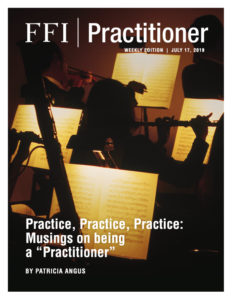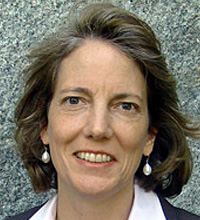
View this edition in our enhanced digital edition format with supporting visual insight and information.
Thank you to this week’s contributor, Patricia Angus, who continues our series of FFI Practitioner articles written by members of the Editorial Committee. In this edition, Patricia examines what it truly means to be a “Practitioner” and the impact of ongoing practice when working with family enterprise clients.
“How do you get to Carnegie Hall?”
“Practice, practice, practice.”
I was recently reminded of the age-old joke about getting to Carnegie Hall as I headed there to hear a friend sing Verdi’s Requiem with her choral group at a special event this Spring. As I navigated the streets of New York City at rush hour, making lefts and rights at crosswalks and weaving through masses of people doing the same, I found myself reflecting on how much practice had gone into the event I was about to attend. I knew that my friend, who has a “day job” in wealth management, had for years been taking voice classes, honing her technique, and joining others with musical talent to produce beautiful sounds from notes and words on a page. Practice indeed. It had gotten her to Carnegie Hall. And what, I wondered, of the “practice” behind being a Practitioner in the field of advising families and their firms? Do we truly “practice?” Why are we called “practitioners,” when so much of the world wants to see us (and many of us want to see ourselves) as “businessmen/ women” or “professionals?” Are these distinctions with a difference? For the reasons below, I would say resoundingly, “yes.”
In times past, there was a fairly bright line of distinction between professionals with “practices” and entrepreneurs and managers who were “in business.” Over time the line has been blurred almost beyond recognition, as even “Baristas” referred to their work as a “profession” and consultants proudly claim to be “businesspersons.” Despite this conflation, I would argue that it’s worth remembering the importance of practice and avoiding the attraction of describing one’s work as “business.”
What is a “practice?”
Doctors have “medical practices;” lawyer have law practices. The word was carefully chosen long ago to reflect the fact that a professional who studied an area in great depth, and obtained the requisite qualifications, could then “practice” their skills, with individual clients, as they pursued their careers over a lifetime. More than a vocation, this meant that there would be no “product” to be sold and no immediate, commercial, end in mind. A “practice” would be built around a series of activities – consistently applying and adapting knowledge and experience to the specific individual needs of a presenting client. This didn’t mean that one’s work would be done without sound business principles – charging the proper amount, keeping books and making projections – but rather recognizing that the core work is never quite done and must always be tailored to each individual client.
How does one “practice?”
Just as one doesn’t arrive at the tee box of a golf course and hit a hole-in-one on the first try (or for most, ever), it’s not possible to just advise a family or its firm without extensive knowledge, training and exposure to a variety of client situations. This can feel quite disconcerting, especially in a world where technological and other advances have given a sense that perfection is possible, and that certainty is attainable. But, for a family enterprise consultant, or wealth advisor, or lawyer, each engagement comes anew, with a fresh set of facts and nuances that cannot, in fact, be fit into a neat box or package (if only!). Rather, the best an advisor can do is learn as much as possible (including, ideally, an advanced degree in one of the traditional professional fields), align early in one’s career with others who are willing to teach (harder to find in the current work environment, but not impossible), and then engage fully in client engagements that require one to push the limits of knowledge to help transform their client family and firms’ experiences.
Importantly, this kind of practice involves the full understanding by clients that they’ve hired a “practitioner” who will not provide black and white “answers” nor deliver a “product” that will meet all their needs. At the same time, “practitioners” who believe that they can spend time establishing a single model or framework or “product” that will apply to all (or even most) clients fool themselves if they believe they are “practicing.” Each client is different, and rarely if ever does a hole-in-one solution presents itself as possible.
Practice, Practice, Practice
This all sounds so obvious, doesn’t it? And yet, we live in a time when it goes against the grain to admit that one is “practicing.” Clients demand answers; business models rely on leverage and scale, and there’s pressure to create products that can be sold. That’s all fine, but it’s not “practice.”
As I listened to the magnificent Requiem at Carnegie Hall, I knew that the moment I was experiencing would not be repeated. It was a “one night only” performance, and the group would soon move on to practicing a new repertoire. In similar fashion, a dedicated Practitioner knows that each moment with a client is not repeatable, and human beings do not “scale” well. But there can be beauty in the experience and the transformation that can occur is far more profound than any elegant product that one can buy or sell. Indeed, for the best Practitioners, there is only one answer to the question of how to get “there” – Practice, practice, practice. It’s no joke.
About the Contributor

Patricia Angus, JD, MIA, TEP, is CEO of Angus Advisory Group LLC and an adjunct professor at Columbia University Graduate School of Business, where she is founding Managing Director of the Family Business Program. A recognized thought leader in multi-generational family governance and wealth, she has advised families with businesses, trusts, and charitable foundations for more than two decades, building bridges across disciplines through her teaching, education, and thought leadership. The author of The Trustee Primer: A Guide for Personal Trustees, Patricia is an FFI Fellow, faculty member in the FFI Global Education Network (GEN), and the recipient of the 2019 Interdisciplinary Award. She can be reached at [email protected].
About Angus Advisory Group
Angus Advisory Group LLC consults to individuals, families, and organizations on family wealth, business, philanthropy, and related issues.

View this edition in our enhanced digital edition format with supporting visual insight and information.





